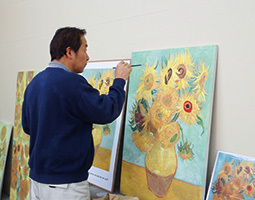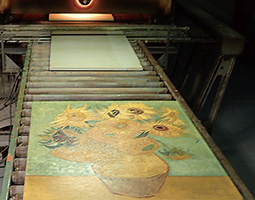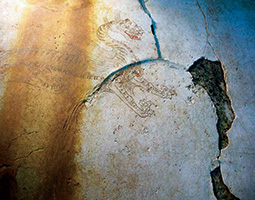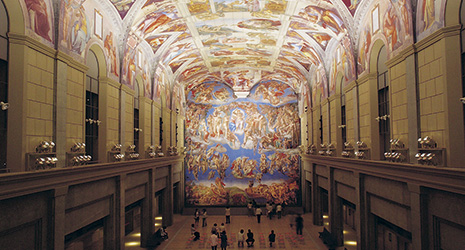INDEX

Technicians paint on glaze multiple times to reproduce the colors and spatial effects of the originals 
Firing a ceramic plate 
The White Tiger from the Kitora Tumulus, reproduced on a ceramic plate. Stains and cracks from the original mural have been faithfully reproduced
December 2020
Masterpieces Immortalized with Ceramics

Master artwork from around the world has been faithfully reproduced and immortalized through the addition of the latest technology to traditional Japanese ceramic technology.

More than 1,000 replicas of masterpieces are on display at the Otsuka Museum of Art in Naruto City, Tokushima Prefecture, which opened in 1998, including the ceiling paintings of the Sistine Chapel, Leonardo da Vinci’s Mona Lisa and Picasso’s Guernica. All of these replicas have faithfully reproduced the size, color, brushwork, and more of the originals on ceramic panels. The quality of the reproductions has been highly praised by the owners of the originals.
The company that produces these works is Otsuka Ohmi Ceramics Co., Ltd., whose manufacturing base is located in Shigaraki Town in Koka City, Shiga Prefecture. This is a production area for Shigaraki ware, which is known as one of many representative Japanese ceramics. This company, established in 1973 as the housing department of the Otsuka Pharmaceutical Group at that time, began with tile production as its primary business, using the white sands of Naruto as a material.
President Osugi Eitsugu says, “Just when we were trying to start tile production, demand for construction tiles was no longer expected due to the 1970s oil crises, and so an idea emerged to create added value by using techniques for painting ceramics to reproduce masterpieces.”

Production of full-scale replicas of masterpieces begins with obtaining consent from copyright holders and examining the originals on-site. While examining, company technicians record delicate flaws and rough spots in great detail and take photos from a variety of angles and in a variety of conditions. They then separate the colors from the obtained image data and create a copy sheet that has been printed multiple times, once in each color, with ceramic paint. This is then placed over a ceramic plate and fixed (fired) onto the plate by firing it for approximately eight hours at 1,000 to 1,350 degrees Celsius. The technicians then reproduce the subtle, detailed color hues, textures, brushwork and spatial effects by repeatedly covering the tiles in glaze, an impervious coating, by hand. When the glaze is fired, the color shade changes, and this firing and coloring is repeated while calculating the finish, sometimes even up to five to six times.
Normally, ceramics can only be fired once as they become deformed or break. Otsuka Ohmi Ceramics made it possible to fire ceramics multiple times through research into the material mixture and firing temperatures, and more than 20,000 colors can be reproduced through glazing.
The current maximum size for ceramic plates is 3 meters by 90 centimeters—the largest such plate in the world—and works of art that are larger than this are divided and made in sections. Only works that have been granted consent through a final inspection by supervisors and the owner of the original are publicly displayed.

Osugi says, “It is difficult to reproduce colors precisely. A variety of expressions are born for the first time not just with color numbers but also through controlling the glass-like gloss unique to glazing. We have learned a lot from the glazing techniques that have been collected here in Shigaraki.”
The greatest merit of ceramic plate masterpiece replicas is their sturdiness, as their color won’t fade, even after 2,000 years. You can view the ceramic replicas in a bright room or outdoors, even for works where the original cannot be viewed except in low-level protective lighting to protect against humidity and light. And as you can also directly touch the ceramic plates, a new way to appreciate art is born, allowing you to sense the texture of the material and the roughness of the paint.
Receiving a request from the Agency for Cultural Affairs, Government of Japan in 2009, Otsuka Ohmi Ceramics worked on a replica of a mural painted on the Kitora Tumulus rock tomb in Nara Prefecture. The Kitora Tumulus is presumed to have been built sometime between the end of the seventh century and the beginning of the eighth century, and painted in rich colors on the ceiling and walls of this tomb (D 2.4 m x W 1 m x H 1.2 m) are an astronomical chart, the Azure Dragon, the White Tiger and other divine beasts. For this project, the painted mural, along with the texture of the plaster walls, cracks, and more, was accurately reproduced with experts, based on nearly 30,000 pieces of image data. Otsuka Ohmi Ceramics’ ceramic plate replicas were awarded the Prime Minister’s Award, the Ministry of Economy, Trade and Industry’s Monodzukuri Nippon (Japan’s Manufacturing) Grand Award, in 2018 for being a valid form of academic preservation and exhibition.

Osugi says, “We will focus our efforts on training our technicians while also advancing technical development that increases reproducibility and expressivity with ceramic plates by applying techniques such as laminating* and cutting utilizing data gained from 3D scans.”
The latest technology, traditional techniques cultivated in Shigaraki, and the precise handiwork of technicians will reproduce the valuable cultural assets of Japan and the world, and by doing so, pass them on to the future.
* Laminating refers to the uniting of superposed layers of one or more materials.

